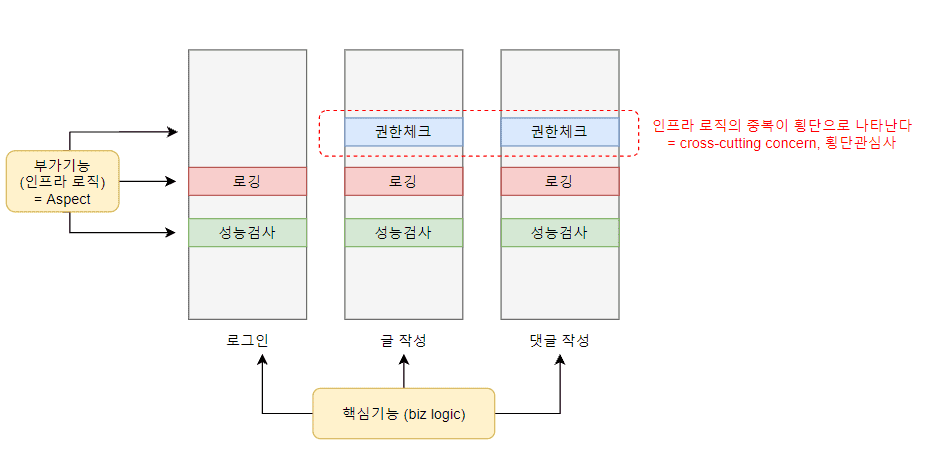[Spring] AOP (관점 지향 프로그래밍)
October 04, 2021
AOP
Aspect Oriented Programming, 관점 지향 프로그래밍
OOP(Object Oriental Programming, 객체 지향 프로그래밍)의 핵심 단위는클래스이다. 한 클래스가 단일 책임을 가지도록 분리한다.- AOP에서 핵심 단위는
Aspect(관점, 관심사)이다. 즉, 필수적이지만 어쩔 수 없이 반복적으로 사용되는 코드들을 분리하여 모듈성을 증가시킨다. - AOP는 OOP의 단점(코드의 중복, 유지보수의 어려움, 재사용성 저하)를 보완해줄 수 있다.
Aspect?
로그기록, 성능측정, .. 등과 같은 부가기능이다. 즉 핵심 비즈니스 로직이 필요로 하는 인프라 로직이라고 생각하면 된다.
애플리케이션 전체에 걸쳐서 중복되어 사용되는 공통기능이다.
비즈니스 로직을 수행하는 데 있어 부가기능이 되는 인프라 로직의 중복이 횡단으로 나타나기 때문에 cross-cutting concern(횡단 관심사)라고 부른다.
[상황 가정]
🙍♂️ : 로그인 기능의 로그 기록 좀 해주세요
🙍♀️ : ㅇㅋ (그냥 회원가입 메소드에 로그기록을 하는 메소드를 추가하면 된다)
🙍♂️ : 잘했어요. 이제 어플리케이션 내의 1억 개의 메소드에 모두 로깅 추가해주세요
🙍♀️ : (도망간다)
👉 바로 이런 경우 도망가지 않고 AOP 사용!
- 핵심 관심 로직과 횡단 관심 로직(=공통 관심 로직)을 분리해서 각 모듈로 개발 - 이후 핵심 로직 코드의 수정 없이도 횡단 관심 로직을 적용하도록 할 수 있음

💎 자바에서 AOP라는 패러다임을 구현하는 구현체는 AspectJ이다.
Spring AOP는 AspectJ를 가져와서 사용한다.
AOP의 주요 개념

[이미지 출처] https://elevatingcodingclub.tistory.com/13
Target
- 핵심 로직을 구현하는 클래스 = 비즈니스 로직
- 공통기능을 적용받게 되는 대상
Advice
- 공통기능을 언제 핵심 로직에 적용할지를 정의
-
스프링에서는 5가지 지점 가능
- Before
- After
- AfterReturning
- AfterThrowing
- Around
JoinPoints
- 연결점. Aspect를 적용할 수 있는 지점. Pointcut은 joinPoints의 부분집합임
- AspectJ에서는 메서드 호출, 메서드 실행, 필드, 객체, 생성자 등 다양한 JoinPoints가 구현돼있긴 하지만 스프링 AOP에서는 메서드가 실행될 때 만으로 한정되어 있다.
Pointcut
- 공통 관심 기능을 적용할 핵심로직의 타겟 메소드를 선택하는 지시자
Weaving
- 공통 관심 기능을 핵심 로직에 적용하는 것
-
Weaving 방식 3가지
- 컴파일 시점 : AOP가 적용된 새로운 클래스 파일이 생성됨
- 클래스 로딩 시점 : 로딩한 바이트코드를 AOP가 변경하여 사용
- ⭐ 런타임 시점(Spring AOP에서 사용하는 방법) : 소스코드나 클래스 정보 자체를 변경하지 않음.
Proxy 패턴를 이용하여 AOP 적용한다.
💡 Proxy 패턴
Proxy는 ‘대리자’라는 뜻을 가지고 있다.
즉, 클라이언트가 사용하려고 하는 대상(타겟)을 대신해서, 실제 대상인 것처럼 위장해서 클라이언트의 요청을 받아주는 클래스이다.
클라이언트는 타겟을 직접 호출하는 게 아니라 Proxy를 호출하고, Proxy는 실제 클래스를 호출해서 실제 클래스에서 반환받은 값을 클라이언트에게 전달한다.
이것이 가능한 이유는 프록시 클래스가 실제 타겟 클래스가 구현하고 있는 인터페이스와 동일한 인터페이스를 구현하고 있기 때문이다.
- 즉 부가기능을 핵심로직에 해당하는 실제 클래스가 아니라 Proxy에다가 코딩할 수 있게 되는 것
-
스프링에서는 런타임시에 자동으로 프록시 객체를 생성한다.
JDK Dynamic Proxy: 타겟 대상이 인터페이스를 구현하는 클래스이면, 인터페이스를 기반으로 동적으로 프록시 객체를 생성한다.CGlib: 타겟 대상이 인터페이스를 구현하고 있지 않는 클래스라면, CGlib를 통해서 클래스에 대한 프록시 객체를 생성한다. CGlib는 대상 클래스를 상속받아 구현한다.
실습 예제
글 작성과 댓글 작성 기능을 핵심 로직으로 하는 어플리케이션이 있다고 가정하자. (예제를 간단히 하기 위해 실제 기능을 1도 구현하지 않은 예제임)
<Biz.java> : 핵심 로직이 구현된 클래스
package biz;
public class Biz {
public String posting() {
System.out.println("글 작성하는 메소드입니다. 핵심 로직입니다.");
return "작성한 글";
}
public void comment(String name) throws Exception {
if (name != "보리") {
throw new Exception("예외를 발생시켜보겠습니다.");
}else {
System.out.println("댓글 작성하는 메소드입니다. 핵심 로직입니다.");
}
}
}여기에 여러 부가 기능들을 적용시키려고 한다. 예제 코드에는 메소드가 2개밖에 없지만 메소드가 1억개쯤 있는 어플리케이션이라면 각 메소드마다 하나하나 부가기능을 추가하기 어려울 것이다. 필요한 부가기능들을 분리하여 Aspect로 개발한다.
(1) XML 스키마 기반
아래와 같은 부가 기능들을 적용한다고 가정하자.
<Common.java> : 핵심로직 전반에 걸쳐 공통적으로 사용될 횡단 관심 기능들을 구현한 클래스
package common;
public class Common {
// 핵심로직 실행 전 실행될 부가기능
public static void authCheck() {
System.out.println("핵심로직 실행 전 권한 체크를 하는 메소드입니다.");
}
// 핵심로직 실행 후 실행될 부가기능
public static String logging() {
System.out.println("핵심로직 실행 후 로그 기록을 남기는 메소드입니다.");
return "로그기록";
}
// 핵심로직 메소드의 리턴값 반환 후 실행될 부가기능
public static void afterReturn() {
System.out.println("리턴되었습니다.");
}
// 핵심로직에서 예외 발생시 실행될 부가기능
public static void exception(Exception e) {
System.out.println(e.getMessage());
}
}<config.xml> : Spring Bean Configuration 파일
<?xml version="1.0" encoding="UTF-8"?>
<beans xmlns="http://www.springframework.org/schema/beans"
xmlns:xsi="http://www.w3.org/2001/XMLSchema-instance"
xmlns:aop="http://www.springframework.org/schema/aop"
xmlns:context="http://www.springframework.org/schema/context"
xsi:schemaLocation="http://www.springframework.org/schema/beans http://www.springframework.org/schema/beans/spring-beans.xsd
http://www.springframework.org/schema/aop http://www.springframework.org/schema/aop/spring-aop-4.3.xsd
http://www.springframework.org/schema/context http://www.springframework.org/schema/context/spring-context-4.3.xsd">
<!-- AOP 사용을 위한 필수 설정 -->
<aop:aspectj-autoproxy />
<!-- Spring bean 등록 -->
<bean id="biz" class="biz.Biz" />
<bean id="common" class="common.Common" />
<!-- AOP 설정 -->
<aop:config>
<!-- 핵심기능의 어느 메소드에 적용할지 포인트컷 지정 -->
<aop:pointcut id="bizLogic" expression="execution(* biz.Biz.*(..))" /> <!-- biz 패키지 내 Biz 클래스의 모든 메소드(파라미터 무관)에 적용하겠다는 뜻 -->
<!-- 공통기능(aspect) 지정 -->
<aop:aspect ref="common">
<aop:before method="authCheck" pointcut-ref="bizLogic"/> <!-- authCheck라는 공통기능을 before 시점에 bizLogic이라는 핵심기능에 적용하겠다 -->
<aop:after method="logging" pointcut-ref="bizLogic"/>
<aop:after-returning method="afterReturn" returning="v" pointcut-ref="bizLogic"/>
<aop:after-throwing method="exception" throwing="e" pointcut-ref="bizLogic"/>
</aop:aspect>
</aop:config>
</beans>이와 같이 설정 후 메인 메소드에서 테스트해보자.
<AOPTest.java>
package running;
import org.springframework.context.ApplicationContext;
import org.springframework.context.support.ClassPathXmlApplicationContext;
import biz.Biz;
public class AOPTest {
public static void main(String[] args) {
ApplicationContext context = new ClassPathXmlApplicationContext("config.xml");
Biz b = context.getBean("biz", Biz.class);
System.out.println("=== 핵심기능 1 실행 ===");
b.posting();
System.out.println("=== 핵심기능 2 실행 ===");
try {
b.comment("리태");
} catch (Exception e) {
// TODO Auto-generated catch block
}
}
}실행결과

before, after, throwing, returning을 모두 수용 가능한 Around Advice로 만들 수도 있다.
<Common.java>
package common;
import org.aspectj.lang.ProceedingJoinPoint;
public class Common {
public Object aroundCommon(ProceedingJoinPoint point) { // ProceedingJoinPoint : around를 처리할 수 있게 하는 인터페이스
// before
System.out.println("핵심로직 실행 전 권한 체크를 하는 메소드입니다.");
// 핵심로직
Object v = null;
try {
v = point.proceed(); // proceed(): 실제 호출된 핵심로직 메소드 실행
} catch (Throwable e) {
// throwing
System.out.println(e.getMessage()); // throwing
}
// after & after returning
System.out.println("핵심로직 실행 후 로그 기록을 남기는 메소드입니다.");
System.out.println("리턴되었습니다.");
return v; // 핵심로직 실행결과값 반환
}
}<config.xml>
<?xml version="1.0" encoding="UTF-8"?>
<beans xmlns="http://www.springframework.org/schema/beans"
xmlns:xsi="http://www.w3.org/2001/XMLSchema-instance"
xmlns:aop="http://www.springframework.org/schema/aop"
xmlns:context="http://www.springframework.org/schema/context"
xsi:schemaLocation="http://www.springframework.org/schema/beans http://www.springframework.org/schema/beans/spring-beans.xsd
http://www.springframework.org/schema/aop http://www.springframework.org/schema/aop/spring-aop-4.3.xsd
http://www.springframework.org/schema/context http://www.springframework.org/schema/context/spring-context-4.3.xsd">
<aop:aspectj-autoproxy />
<bean id="biz" class="biz.Biz" />
<bean id="common" class="common.Common" />
<aop:config>
<aop:pointcut id="bizLogic" expression="execution(* biz.Biz.*(..))" />
<aop:aspect ref="common">
<aop:around method="aroundCommon" pointcut-ref="bizLogic" />
</aop:aspect>
</aop:config>
</beans>(2) Annotation 기반
위 예제를 어노테이션을 사용하는 방식으로 바꿔보자.
<config.xml>
<?xml version="1.0" encoding="UTF-8"?>
<beans xmlns="http://www.springframework.org/schema/beans"
xmlns:xsi="http://www.w3.org/2001/XMLSchema-instance"
xmlns:aop="http://www.springframework.org/schema/aop"
xmlns:context="http://www.springframework.org/schema/context"
xsi:schemaLocation="http://www.springframework.org/schema/beans http://www.springframework.org/schema/beans/spring-beans.xsd
http://www.springframework.org/schema/aop http://www.springframework.org/schema/aop/spring-aop-4.3.xsd
http://www.springframework.org/schema/context http://www.springframework.org/schema/context/spring-context-4.3.xsd">
<aop:aspectj-autoproxy />
<!-- annotation 사용하겠다는 설정 -->
<context:annotation-config />
<!-- 스프링빈으로 등록한 자바 클래스가 어느 패키지에 있는지 지정 -->
<context:component-scan base-package="biz" />
<context:component-scan base-package="common" />
</beans>핵심 기능, 공통 기능 클래스에 @Component 어노테이션 붙여서 스프링빈으로 등록해주고, 공통 기능 클래스에 AOP로 등록하는 어노테이션을 붙여준다.
<Biz.java>
package biz;
import org.springframework.stereotype.Component;
@Component
public class Biz {
public String posting() {
System.out.println("글 작성하는 메소드입니다. 핵심 로직입니다.");
return "작성한 글";
}
public void comment(String name) throws Exception {
if (name != "보리") {
throw new Exception("예외를 발생시켜보겠습니다.");
}else {
System.out.println("댓글 작성하는 메소드입니다. 핵심 로직입니다.");
}
}
}<Common.java>
package common;
import org.aspectj.lang.annotation.After;
import org.aspectj.lang.annotation.AfterReturning;
import org.aspectj.lang.annotation.AfterThrowing;
import org.aspectj.lang.annotation.Aspect;
import org.aspectj.lang.annotation.Before;
import org.springframework.stereotype.Component;
@Aspect
@Component
public class Common {
@Before("execution(* biz.Biz.*(..))")
public static void authCheck() {
System.out.println("핵심로직 실행 전 권한 체크를 하는 메소드입니다.");
}
@After("execution(* biz.Biz.*(..))")
public static String logging() {
System.out.println("핵심로직 실행 후 로그 기록을 남기는 메소드입니다.");
return "로그기록";
}
@AfterReturning(pointcut="execution(* biz.Biz.*(..))", returning="v")
public static void afterReturn() {
System.out.println("리턴되었습니다.");
}
@AfterThrowing(pointcut="execution(* biz.Biz.*(..))", throwing="e")
public static void exception(Exception e) {
System.out.println(e.getMessage());
}
}Around 를 사용할 경우
package common;
import org.aspectj.lang.ProceedingJoinPoint;
import org.aspectj.lang.annotation.Around;
import org.aspectj.lang.annotation.Aspect;
import org.springframework.stereotype.Component;
@Aspect
@Component
public class Common {
@Around("execution(* biz.Biz.*(..))")
public Object aroundCommon(ProceedingJoinPoint point) {
// before
System.out.println("핵심로직 실행 전 권한 체크를 하는 메소드입니다.");
// 핵심로직
Object v = null;
try {
v = point.proceed();
} catch (Throwable e) {
// throwing
System.out.println(e.getMessage()); // throwing
}
// after & after returning
System.out.println("핵심로직 실행 후 로그 기록을 남기는 메소드입니다.");
System.out.println("리턴되었습니다.");
return v;
}
}